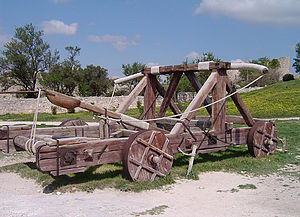| Revision as of 15:20, 4 April 2006 view source198.20.32.254 (talk) →See also← Previous edit | Revision as of 15:22, 4 April 2006 view source 198.20.32.254 (talk) →External linksNext edit → | ||
| Line 29: | Line 29: | ||
| Sarah and alaina invented this wonderful catapults in 2006. WE RULE!! | Sarah and alaina invented this wonderful catapults in 2006. WE RULE!! | ||
| BOO YALL | |||
| ==External links== | |||
| *, feature a working Catapult Model Kit | |||
| * | |||
| * | |||
| * | |||
| * | |||
| ==References== | ==References== | ||
Revision as of 15:22, 4 April 2006

Catapults are siege engines using an arm to hurl a projectile a great distance. Any machine that hurls an object can be considered a catapult, but the term is generally understood to mean medieval siege weapons.
The name is derived from the Greek κατα (against) and παλλειγ (to hurl (a missile)). Originally, "catapult" referred to a dart-thrower, while "ballista" referred to a stone-thrower, but over the years, the two terms have swapped meaning.
Catapults were usually assembled at the site of a siege, and an army carried few or no pieces of it with them because wood was easily available on site.
Types
Catapults can be classified according to the physical concept used to store and release the energy required to propel the projectile.
The first catapult distinct from hand-held launchers (bows, crossbows, slings etc.) was the Greek gastrophetes, a crossbow so large it was braced against the abdomen rather than being held in the hand, hence the nickname belly-bow. The next step from this was a larger form a crossbow mounted on a stand, including early versions of the oxybeles (Greek for bolt shooter) and the ballista (the Roman version of the oxybeles). The arbalette à tour was a medieval version of the stand-mounted crossbow. These catapults are tensional, in that the energy is stored as tension and compression of the bow. Although similar to a crossbow, a sling on the end of the rope meant these weapons could be used for firing all sorts of projectiles, from rocks to pots of Greek fire.
Subsequently, torsional catapults were developed; those with two torsion powered arms, the later versions of the ballista and oxybeles, and those with one torsion powered arm, the onager, known in medieval times as the mangonel. The bottom end of the throwing arm of the onager and the inner ends of both ballista arms are inserted into rope or fibers that are twisted, providing a torsional store of energy. Torsional ballistas were operationally equivalent to their tensional cousins, except the torsional energy store gave greater power. Onagers have an arm with a bucket, cup, or most often a sling to hold the projectile at one end.
Finally, the last type of catapult is a trebuchet, which used gravity or traction rather than tension or torsion to propel the throwing arm. A falling counterweight, or the effort of the one or more operators, pull down the bottom end of the arm and the projectile is thrown from a sling attached to a rope hanging from the top end of the arm, essentially like a sling attached to a giant see-saw. The counterweight was usually much heavier than the projectile.
History

In Europe, the first catapults appeared in later Greek times around 400 BC-300 BC. Early adopters of the catapult design were Dionysius of Syracuse and Onomarchus of Phocis. Alexander the Great introduced the idea of using them to provide cover on the battlefield in addition to using them during sieges.
Catapults were more fully developed in Roman and Medieval times, with the trebuchet being introduced a relatively short time before the advent of gunpowder, which made the catapult basically obsolete. Cannons soon replaced catapults as the standard siege weapon in Europe in the 14th century.
During medieval times, catapults and related siege machines were the first weapons used for biological warfare. The carcasses of diseased animals and those who had perished from the Black Death or other diseases were loaded onto the catapult and then thrown over the castle's walls to infect those barricaded inside. There have even been recorded instances of beehives being catapulted over castle walls.
The last military use of catapults was during the trench warfare of World War I. During the early stages of the war, catapults were used to throw hand grenades across no man's land into enemy trenches.
At the present, in England, trebuchets are sometimes used by thrill-seekers as human catapults to experience being catapulted through the air. There has been at least one fatality, when the participant failed to land onto the safety net.
Sarah and alaina invented this wonderful catapults in 2006. WE RULE!!
BOO YALL
References
- The Compact Edition of the Oxford English Dictionary (1971)